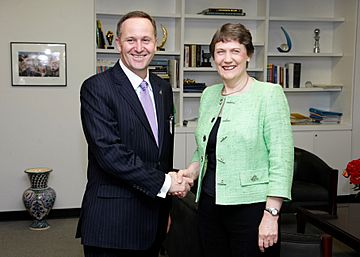Prime Minister of New Zealand facts for kids
Quick facts for kids Prime Minister of New Zealand |
|
|---|---|

|
|

|
|
| Department of the Prime Minister and Cabinet | |
| Style |
|
| Abbreviation | PM |
| Member of |
|
| Reports to | House of Representatives |
| Residence | Premier House, Wellington |
| Seat | The Beehive, Wellington |
| Appointer | Governor-General |
| Term length | At the Governor-General's pleasure |
| Formation | 7 May 1856 |
| First holder | Henry Sewell |
| Deputy | Deputy Prime Minister of New Zealand |
| Salary | NZ$498,300 |
The prime minister of New Zealand (in Māori, Te pirimia o Aotearoa) is the main leader of the New Zealand government. Think of them as the chief executive of the country. The current prime minister is Christopher Luxon. He became prime minister on 27 November 2023. He is also the leader of the New Zealand National Party.
The prime minister is the most important government minister. They lead meetings of the Cabinet, which is a group of top ministers. They also decide which jobs other ministers get. The prime minister speaks for the government and gives advice to the King or Queen or their representative, the Governor-General. The prime minister also oversees the Department of the Prime Minister and Cabinet. This department helps the prime minister and is located in the Beehive in Wellington.
The job of prime minister started a long time ago. It came from traditions in the United Kingdom, which used to rule New Zealand. When the job is empty, the Governor-General chooses someone who has the most support from the House of Representatives. This person is usually the leader of the political party with the most seats. The prime minister and the Cabinet are responsible for their actions to the Governor-General, the House of Representatives, their party, and the people of New Zealand.
At first, the leader of the government was called "colonial secretary" or "first minister." In 1869, the name changed to "premier." This title was used for over 30 years. Then, in 1900, Richard Seddon changed it to "prime minister." New Zealand became a Dominion in 1907, and the title "prime minister" stuck. In Māori, "pirimia" means "premier." New Zealand prime ministers are called "The Right Honourable" for life.
Forty-two people have been prime minister. This includes thirty-nine men and three women. The first was Henry Sewell, who started on 7 May 1856. Richard Seddon served the longest, for over 13 years. Henry Sewell served the shortest time, only two weeks.
Contents
Choosing the Prime Minister
The Governor-General officially appoints the prime minister. This is done on behalf of the King or Queen. The Governor-General chooses the person who is most likely to have the support of most elected Members of Parliament (MPs). This person is usually the leader of the biggest political party that forms the government. The prime minister might lead a government with more than one party, called a coalition government.
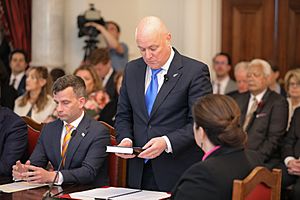
Once appointed, the prime minister stays in the job until they resign, are removed, or pass away. The Governor-General can theoretically remove a prime minister at any time. However, this power is almost never used. It might happen if the prime minister loses a vote of no confidence in the House of Representatives.
If a prime minister loses the support of the House, they should resign. This also happens after an election if their party no longer has enough support. General elections happen every three years. This means a prime minister's time in office is limited unless they win another election.
What the Prime Minister Does
The prime minister's job is not written down in a single law. Instead, it's based on old traditions called "constitutional conventions." These traditions mean the prime minister and other ministers must keep the support of the House of Representatives. The prime minister leads the Cabinet, which is a group that makes big decisions.
The Cabinet Manual explains the prime minister's duties.
Advising the King or Queen
The prime minister is the main person who advises the King or Queen. As long as they have Parliament's support, they alone can advise the monarch on:
- Choosing or removing the Governor-General.
- Changes to the rules for the Governor-General's job.
- Giving out New Zealand honours (awards), except for special ones from the monarch.
Advising the Governor-General
As the head of government, the prime minister is the only one who can advise the Governor-General to:
- Appoint, remove, or accept resignations of other ministers.
- End Parliament and call for a new election. The Governor-General can say no to this if the prime minister has just lost a vote of confidence. However, this has never happened.
Leading the Government
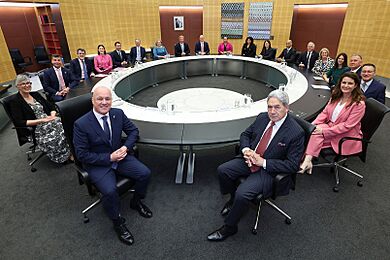
The prime minister is seen as "first among equals." This means they are the most important, but they must also agree with decisions made by the Cabinet. The prime minister cannot just give direct orders. Their power comes from other things, like:
- Setting the agenda for Cabinet meetings.
- Choosing and removing ministers, and giving them their jobs.
- Their influence as the leader of the main political party.
- Being central to most important decisions.
Since 1996, New Zealand has used the MMP electoral system. This means prime ministers often have to work with other parties to form a government. This can limit what the prime minister can do alone.
Other Important Roles
Prime ministers often take on extra jobs (called portfolios) to focus on certain areas. In the past, prime ministers often handled finance or foreign affairs. Today, they choose portfolios that match their interests. For example, Helen Clark was minister for arts, culture, and heritage. John Key was minister of tourism. Jacinda Ardern became minister for child-poverty reduction.
Even if they are not the foreign affairs minister, the prime minister still welcomes leaders from other countries. They also visit other countries and attend international meetings.
The prime minister is also in charge of the Department of the Prime Minister and Cabinet (DPMC). This department helps the Cabinet with advice and makes sure government plans are carried out. Since 2014, the prime minister has also overseen national security and intelligence.
Benefits of the Job
Salary and Home
The prime minister's salary is decided each year by an independent group. As of July 2024, the prime minister's salary is NZ$498,300. They also get money for travel and housing, just like other MPs. Their family also gets these allowances.
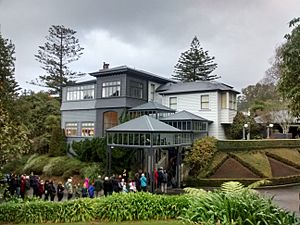
The prime minister's official home is Premier House in Wellington. They use it to host events for guests from New Zealand and other countries. Unlike some other leaders' homes, Premier House is not where the government works. The prime minister's office is in the Beehive, near Parliament.
Prime ministers are given the title "The Right Honourable" when they start their job. They keep this title for the rest of their lives. It is also common for the King or Queen to give a knighthood or damehood to prime ministers after they leave office.
Security and Travel
A special police group, the Dignitary Protection Service (DPS), protects the prime minister and their family. They also protect other important people.
The DPS provides transport for the prime minister. They are driven in special BMW cars. For domestic flights, they usually use regular Air New Zealand planes. For international travel, they use Royal New Zealand Air Force planes, usually Boeing 757s. These planes have been updated with work stations and special communication tools.
After Leaving Office
Former prime ministers receive a yearly payment and travel money for life. If they held the job for at least two years, they get $10,900 for each year they served, up to a maximum of $54,500 per year. They can also get travel payments for official duties within New Zealand.
If a current or former prime minister passes away, they can have a state funeral. This depends on their family's wishes.
History of the Role
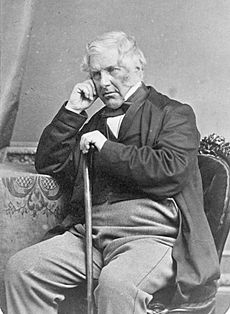
If we count Henry Sewell as the first, 42 people have been prime minister. Some have held the job multiple times. William Fox and Harry Atkinson both served four times. Richard Seddon served the longest, for 13 years. Henry Sewell served the shortest total time, only 13 days. The youngest premier was Edward Stafford, who was 37 years old in 1856. The oldest was Walter Nash, who was 78 when he left office in 1960.
All New Zealand prime ministers so far have been Pākehā (New Zealand European). Most have British or Irish backgrounds.
New Zealand is one of the few countries to have had three female heads of government. It is also one of only three countries where one female leader directly followed another. The first female prime minister was Jenny Shipley in late 1997. She was followed by Helen Clark in 1999. Jacinda Ardern became prime minister in 2017.
Early Leaders
New Zealand became a British colony in 1841. It was ruled by a Governor, appointed by Britain. New Zealand gained self-government in 1853. The first Parliament met in 1854.
The start of the prime minister's job is debated. The words "prime minister" were used early on for people like James FitzGerald and Thomas Forsaith. But they didn't have official titles.
The first person officially appointed to lead the government was Henry Sewell in April 1856. His title was "colonial secretary." In 1864, Frederick Weld was the sixth leader, and he was called "premier." This title was used for most of the 1800s. However, a law in 1873 mentioned a salary for the "Prime Minister."
At first, premiers just advised the Governor. The Governor had a lot of power. This changed when Edward Stafford started meeting with his ministers outside the official Executive Council. This created the modern way of running the government, called "cabinet government."
Party Leadership
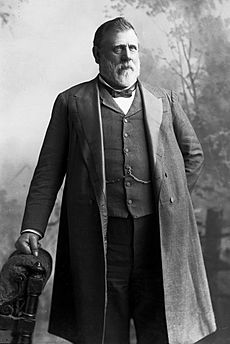
Early premiers were supported by small groups based on personal interests. Their governments did not last long. The premier's power grew when modern political parties formed. Premier John Ballance started the first formal party, the Liberal Party, in 1891. There was not much opposition until 1909, when William Massey formed the Reform Party. After this, political power was centered on parties and their leaders.
After 1900, Richard Seddon started using the title "prime minister." This change was noted in the New Zealand Official Yearbook. William Hall-Jones was the first to be sworn in as "prime minister" in 1906.
The prime minister's power was balanced by the need to work with other Cabinet members and party leaders. Other groups, like Parliament and government departments, also limited the prime minister's power. In 1912, Thomas Mackenzie was the last prime minister to lose power because of a no-confidence vote in the House.
Modern Leadership
The First World War changed how New Zealand worked with the British Empire. In 1917, British Prime Minister David Lloyd George invited New Zealand's prime minister to join the Imperial War Cabinet. In 1919, William Massey signed the Treaty of Versailles for New Zealand. This showed New Zealand's growing independence.
New rules in 1930 made the prime minister's job more important both at home and internationally. The Statute of Westminster 1931 confirmed that Dominions could make their own laws. New Zealand adopted this law in 1947. New Zealand started acting more independently in foreign affairs. In the 1940s, the prime minister's role grew as New Zealand signed many international agreements. In 1967, Keith Holyoake was the first New Zealand prime minister to choose candidates for Governor-General without Britain's help.
After the mixed-member proportional (MMP) voting system started in 1996, prime ministers often had to lead minority governments. This means they needed support from smaller parties. Helen Clark was very good at this during her nine years as prime minister (1999–2008). Her Labour government stayed in power by working with five smaller parties.
Until Helen Clark's time, important New Zealand leaders, including the prime minister, were appointed to the British Privy Council. This gave them the title "Right Honourable." This stopped in 2000. However, in 2010, the King or Queen decided that the prime minister, Governor-General, Speaker of the House, and Chief Justice would again be called "Right Honourable" when appointed.
On 21 June 2018, Jacinda Ardern became the first prime minister of New Zealand to give birth while in office. She was also the first prime minister to lead a single-party majority government since MMP began, from 2020 to 2023.
Deputy Prime Minister
The job of "deputy prime minister" has existed since 1949. The deputy usually holds important government jobs. They become the acting prime minister if the prime minister is away or unable to work. The deputy is usually from the same party as the prime minister. However, in coalition governments, the leader of a smaller party might get the job. David Seymour, leader of ACT New Zealand, has been deputy prime minister since 31 May 2025.
Lists About Prime Ministers
Here are some lists about the 42 people who have been prime minister:
- List of prime ministers of New Zealand
- List of prime ministers of New Zealand by age
- List of prime ministers of New Zealand by place of birth
- List of prime ministers of New Zealand by education
See also
 In Spanish: Primer ministro de Nueva Zelanda para niños
In Spanish: Primer ministro de Nueva Zelanda para niños
- Spouse of the prime minister of New Zealand
- List of New Zealand electorates represented by sitting prime ministers
- Deputy Prime Minister of New Zealand
- New Zealand order of precedence
- List of New Zealand governments
- List of current heads of state and government



